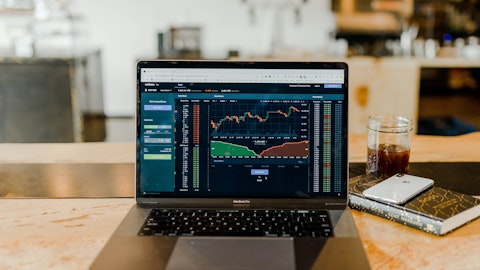Alan Armstrong: Yes. Well, first, I’ll take a high-level cut at that, and then John can provide some more detailed remarks on it. First of all, the base business is continuing to grow nicely. I think how much growth we see in the gathering business next year will be somewhat dependent on producers’ response. And obviously, their response will be somewhat dependent on both the prompt price as well as shape of the forward curve. And so a little bit of TBD, I would say, in terms of volume growth on the gathering systems and as that would affect our gathering revenues. I think on the transmission business, our opportunities there are acceleration of existing projects that we have out there. The team has been doing a great job like they did on REA of bringing that first phase in early.
So I think the opportunities there as you – if you look at our projects, most of those come in, including the big deepwater business comes on towards the end – very end of 2024. So some acceleration of those projects would be where the opportunities would exist on those very tangible and identifiable growth projects that drive a very large increase in 2025. So I think it’s a little bit early right now, frankly, to be calling what we’ll see from the producer community in 2024, and that will probably drive that on the margin. But I’ll let John take the more specifics on that.
John Porter: Not a lot really to add. I do think a really good reference for information about our growth in 2024 and really beyond is in Slide 18 in the appendix, you’re going to spot a number of projects, as Alan mentioned, that will contribute to 2024 based on what we know today, including several projects in the transmission and Deepwater Gulf of Mexico business as well as several gathering and processing expansions. You mentioned the full year of MountainWest Pipeline acquisition and now these DJ transactions that we’re discussing today, too, that will layer into 2024. And you also mentioned working against these increases, we will see the absence of some of the gathering and processing related hedges that we had in place in 2023.
But again, that’s Slide 18 in the appendix, I think, really clearly shows the projects that will be leading to the growth of 2024 and obviously, the much more significant growth in 2025 and beyond. And as Alan mentioned, it kind of shows you the different projects that could potentially add to upside if we’re able to bring them in early.
Brian Reynolds: Great. Thanks. Makes sense. Maybe as my follow-up, we’ve seen the market talk a lot about NGL and LNG opportunity sets over the next, call it, three years to five years with some downstream expansion opportunities. So I was kind of just curious, just given Williams strategic position on the transmission business, if you could just refresh us on your kind of $1 billion to $2 billion CapEx run rate or we could see some lumpy attractive projects ultimately move into the backlog and grow returns just given the thought process that we see 20 Bcf of natural gas demands coming over the next decade. Thanks.
Alan Armstrong: Yes, Brian, thank you. We’re pretty careful to not put things in there until we’ve got pretty high level of optimism about those projects going forward in that backlog. And I would tell you, I would be frankly very surprised if we didn’t see some – a lot of those projects that are in our pipeline move forward, given the amount of demands and projects that are coming on and the way we’re positioned with our infrastructure to serve that. So to answer your question, I think it would be very unlikely that we wouldn’t see some additional projects come in to help serve a lot of these gas demand increases. And I say that from a few fronts. One, if you look at what the alternatives are for power generation, say, in the Northeast now, the answer for power generation up there was going to be offshore wind, that is looking very unlikely now within the decade that we’re looking at right now, and so some other answer is going to have to happen.
Unfortunately, we’ve shut down the Indian Point Nuclear Facility, and there’s pressure to take down other facilities up there. And I just think that’s – people are going to have to get sober pretty quickly here on what the alternatives are up there. I think our customers on REA are going to wind up looking really, really smart for taking that capacity that they took because I think that’s going to be in precious demand. So in the Northeast, I think harsh reality is going to set in here before long. In the Mid-Atlantic, we saw great evidence of demand well beyond what this initial project that we’re building in the Mid-Atlantic States and into the Southeast. And then obviously, the LNG market continues to demand more and more infrastructure in that area that we’re well positioned to serve.
So it would be pretty shocking to me if we didn’t see that – a lot of that backlog into 2025 and 2026 really turned into some pretty material projects up there.
Brian Reynolds: Great. Super helpful. Hopefully some more returns like Southeast Supply. I’ll leave it there. Enjoy the rest of your morning.
Alan Armstrong: Thank you.
Operator: Thank you. We go next now to Jeremy Tonet at [indiscernible]. Jeremy, your line is open, if you do have a question at this time. Hearing no response. We’ll move next now to Tristan Richardson at Scotiabank.
Tristan Richardson: Hey, good morning, guys. Alan, you noted in your comments, you’re surprised at the level of demand you’re seeing as you seek to commercialize healthy supply. I mean, suggesting that there could be other opportunities. Is this a dynamic where the scope of Southeast Supply could change over time? Or are you thinking of addressing this demand really with separate projects and thinking way down the road?
Alan Armstrong: Yes. It’s a great question, Tristan, and you picked up on an important point there. Our issue is that our customers, which are some of our best and biggest customers on Transco are their demands are very urgent. And for us to sit around and wait for – to finalize any more of the demand that was pending out there, really, it doesn’t serve those customers very well. And so we’re moving ahead with those customers that we’re ready to put binding contracts in place. And that – and we’re not – I would just say we’re going to try to protect that – the time line of that project. And that will be kind of first and foremost in our thinking as we move ahead on that. So could that expand a little bit where somebody else coming in under the wire before we do our pre-filing.
Yes, but I’d say, we’re not going to get ourselves strong out there in a way that we can’t move ahead with this initial project because our customers have made it very clear how important it is that we get on with it. So that kind of hopefully gives you a little bit of idea of what we’re dealing with there. But I would say it’s obvious from the open season and from the additional requirements that are continuing to service. I’d be just like I said earlier; I would be very surprised if we didn’t see another project come out of this. It’s just – we’ve got to get on with it because the demands are so.




